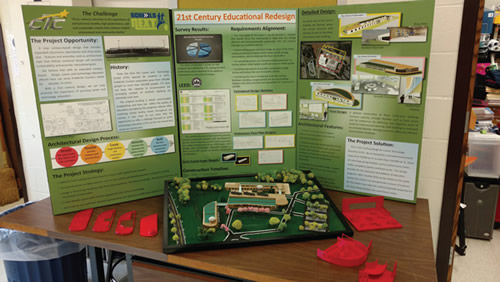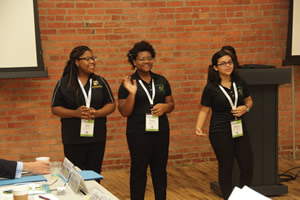Facility Planning
SchoolsNEXT Puts Students at the Center of STEM Learning
- By Victoria Bergsagel
- December 1st, 2016
The SchoolsNEXT program asks students to innovate, iterate and gives them opportunities to take
deep dives into STEM topics of interest to them. Every
fall, teams download materials from the Association for Learning
Environments (A4LE) website and begin designing schools of
the future. In the spring, the association convenes state, and then
regional juries to select the finalist teams that will present to a jury
at its international conference in late September.

PHOTOS © ERIC WEISS/ ERIC WEISS/SCHRADER GROUP ARCHITECTURE
Since 1999, SchoolsNEXT has encouraged middle
school students from across the globe to illustrate
the creativity they can bring to school design.
Together with the National Council of Teachers of
Mathematics and the US Green Building Council,
A4LE developed an award-winning curriculum to
be deployed either in a class or after-school club.
Emphasizing the importance of well-planned,
healthy, safe, sustainable and resilient schools that foster
achievement and enhance community vitality, the program asks
teams to provide multi-disciplinary solutions that follow a robust
planning process from concept to completion. Students then collaborate,
connect with community mentors as role models (local
architects, engineers and scientists), study sustainability, use
computer-assisted design programs, build models, produce videos,
write project narratives and present to real-world audiences as
they take deep dives into topics of interest to them, including science,
design thinking, engineering and green building practices.
STEM 2026
This September, coinciding with my preparation to experience
yet another SchoolsNEXT competition, I read a remarkable new
report jointly released by the U.S. Department of Education and
American Institutes for Research entitled, STEM
2026: A Vision for Innovation in STEM Education.
Promoting a rigorous STEM education and
lifelong learning among youth in all communities,
the report suggests six interconnected
mechanisms to support STEM learning —
which are strikingly similar to the tenets of
SchoolsNEXT.
- Engaged and networked communities of practice connect students
to STEM mentors.
- Accessible learning activities invite intentional play and risk.
- Innovative and accessible measures of learning recognize that
formative assessment can provide valuable insight into the
mindsets and habits associated with successful academic and
postsecondary outcomes.
- Societal and cultural images and environments promote diversity
and opportunity.
- Flexible and inclusive learning spaces are located in schools,
the natural world, makerspaces and learning environments
augmented by innovative technologies.
- Educational experiences include interdisciplinary approaches to
solving “grand challenges.”

PHOTOS © ERIC WEISS/ ERIC WEISS/SCHRADER GROUP ARCHITECTURE
Students presenting at the 2016 SchoolsNEXT competition.x
Meeting the Challenge Ahead
According to STEM 2026, “Recent analyses indicate that during
the next five years, major American companies will need to add a
total of nearly 1.6 million employees to their workforce: 945,000
who possess basic STEM literacy and 635,000 who demonstrate
advanced STEM knowledge.”
Yet daunting challenges remain if the goal of STEM for all is to
be realized. The most recent National Assessment of Educational
Progress (NAEP) results indicate that:
- Compared with 43 percent of White students and 61 percent of
Asian students, just 13 percent and 19 percent of Black and Hispanic
students, respectively, are scoring at or above proficiency
in eighth-grade mathematics.
- In eighth-grade science, 45 percent and 46 percent of White and
Asian students, respectively, perform at or above proficiency,
compared to 20 percent or less of other racial minorities.
- SchoolsNEXT has the potential to address such achievement gaps
by providing mentors and rich STEM experiences, but like so
many other youth development programs, will need to vigilantly
ensure that all students are given such opportunities, not just
those who are naturally afforded them.
Working together with local educators A4LE’s members recruit
diverse students to mentor, invite them into the work place and
offer real-world experiences. They provide materials and professional
insights; and when local students are successful, raise funds
to send their teams to the various venues of the competition.
Testimonials abound around the young lives affected by
SchoolsNEXT. Some of my recollections as a juror include:
- The charm offensive by the young African American students
from John Phillips Sousa Middle School in Washington, DC
whose idea for a historic timeline in their school’s main entry depicting
the school’s rich history of music, desegregation and civil
rights was actually incorporated into the school’s renovation.
- The poise and intelligence of a Latino team from Imago Dei, a
tuition-free middle school for low-income families in Tucson,
Ariz., who designed a school made of local and reused materials
on an abandoned lot in their neighborhood.
- The knowledge of four girls from Mukilteo, Wash., who participated
in a Congressional briefing on sustainability with Senator
Patty Murray’s staff and demonstrated that they knew more
about green building design than most adults in the room.
- The poise of this year’s Award of Excellence winners from
Oregon’s Lake Oswego Junior High whose well-defined planning
process addressed community “needs” and “wants” with
innovative solutions, including a Holodeck for virtual field trips,
vertical green walls for safety and security, CO2-sequestering
concrete and flexible maker spaces.
A Bright Future
It comes as no surprise that young people today believe they genuinely
can, and should, make a difference in their local communities.
SchoolsNEXT’s holistic approach to learning and rich connections between
an ever-increasing network of school, industry and community
partners, offers students opportunities to use high-level thinking and
creativity to solve some of their generation’s most pressing problems.
Cole Webber (a high school student from Ontario, who in the three
years since he participated in the program has written a book, founded
a nonprofit, spoke at 20 international school planning events and served
as an advisor to the Minister of Education in his province) summed up
the program nicely. “SchoolsNEXT was the thing that started it all for
me … I can say first-hand the value of this program. It is not just a fun
project to do in school. This program changes lives.”
This article originally appeared in the December 2016 issue of School Planning & Management.